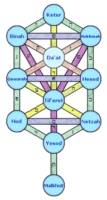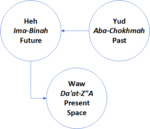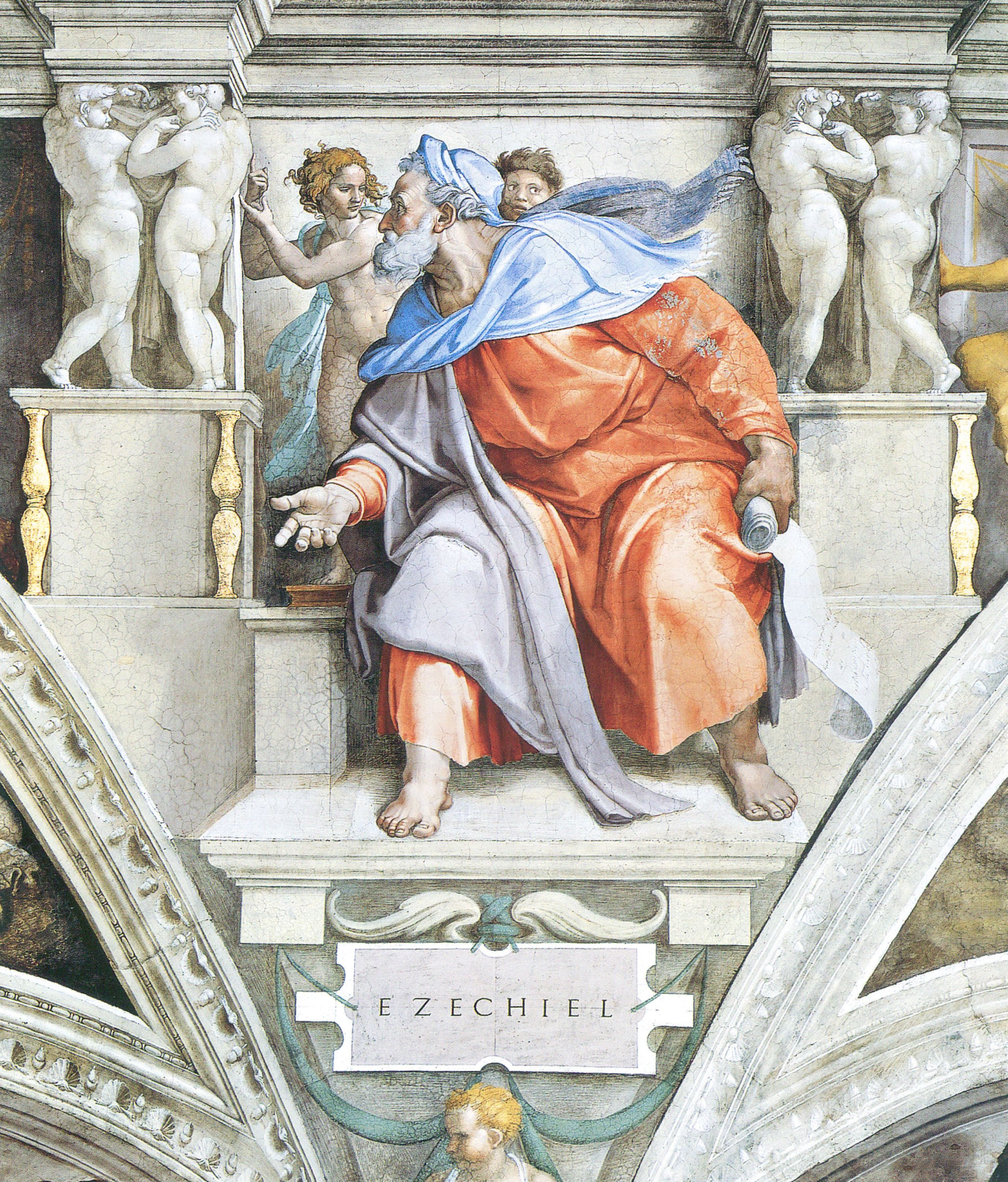Meditations on the Maaseh Merkavah – I
We do science by studying nature. We study physics in a lab, peering into space or working out mathematical models with pencil and paper to see if they fit experimental data. However, great mystics of the past were able to see how this world operates by gazing into spiritual worlds above.
On Shavuot, the holiday when we celebrate the revelation on Mount Sinai, we read the prophecy of Ezekiel (the First Vision of Ezekiel) called Maaseh Merkavah (or Ma’aseh Merkabah)—Work of the Chariot. Masters of Kabbalah have taught us that understanding the Work of the Chariot gives the initiated an understanding of the works of nature. This Shavuot, studying and thinking about Maaseh Merkavah, I came to understand some profound insights about the physics of space and time. I will endeavor to share a few insights, which I gleaned from Maaseh Merkavah, in a series of posts. This is the first post on this topic.
In his prophecy, Ezekiel (Yechezkel) speaks of four living creatures, the beasts (Heb. khayyot or chayot) – four angelic beings. Ezekiel sees them as running and returning (ratzo vashov). Kabbalah and Chasidut explain that this running and returning is what sets off the flow of time, the never-ceasing time-flux. It is explained at length in the series of discourses called Samach Vav (Yom Tov shel Rosh HaShanah) by the fifth Rebbe of Chabad-Lubavitch, Rabbi Sholom Dovber, the Rebbe Rashab. I elaborated on this in my essay “On the Nature of Time and the Age of the Universe.”
Prophet Ezekiel sees the angelic beings, khayyot, as having four faces, which is highly significant. The commentators connect these four faces with four letters of the Proper Name of G‑d, Havayah, or Tetragrammaton—Y‑H‑W‑H (alternatively transliterated as Y‑H‑V‑H). As I wrote in my other posts (see, for example, “I Am Who I Am: Conversation at the Burning Bush”), this Name has to do with time and space. Firstly, the name Havayah connotes the timeless nature of G‑d, as it is seen as a short form of three temporal categories: hayah (is), hoveh (was), yihyeh (will be). Secondly, as it is well known, if we square the numerical values of the letters, we get 186: (Yod)2+(Heh)2+(Waw)2+(Heh)2 =(10)2+(5)2+(6)2+(5)2 = 186. This is the same numerical value as the word Makom: (Mem=40) + (Quf=100) +(Waw=6) + (Mem=40) = 186 – “the space.” Thus, generally, Tetragrammaton hints at the unity of time and space. As we shall see, this connection runs much deeper. However, to see this, familiarity with the basic concepts of Lurianic Kabbalah is required. For those unfamiliar with these concepts, I offer below a brief refresher course on sefirot and partzufim.

Let us recall that the Divine Light (Or Ein Sof) emanates through ten channels, ten Divine emanations called Sefirot (or sephirot): Keter (“Crown,” Divine Will), Ḥokhmah (“Wisdom”), Binah (“Understanding”), Ḥesed (“Kindness”), Gevurah (“Strength,” Judgment), Tiferet (“Beauty,” Compassion), Netzaḥ (“Eternity,” Victory, Endurance), Hod (“Splendor,” Humility), Yesod (“Foundation”), and Malḥut (“Sovereignty,” “Kingdom,” Shekhinah – Divine Presence). These sefirot are typically arranged in three columns—right, left, and middle:
|
Keter Crown |
||
|
Binah Understanding |
Ḥokhmah Wisdom |
|
|
Gevurah Strength, Judgment |
Ḥesed Kindness |
|
|
Tiferet Beauty, Compassion |
||
|
Hod Splendor, Humility |
Netzaḥ Eternity, Victory |
|
|
Yesod Foundation |
||
|
Malḥut Sovereignty, Shechinah |
In the pre-Lurianic kabbalah, Keter is usually counted as the first sefirah. As a crown that sits on top of the king’s head, the sefirah of Keter is so sublime that it is above all worlds. Therefore, in Lurianic Kabbalah, usually, it is replaced by a quasi-sefirah of Da’at (Knowledge), which is also placed in the middle column but is below Ḥokhmah and Binah. Da’at is a reflection of Keter and is a smaller version of it, as it were. The first three sefirot, Ḥokhmah (Wisdom), Binah (Understanding), and Da’at (Knowledge), comprise the three aspects of the Divine intellect. Specifically, Da’at is seen as an interface between the intellect and the emotions, which are represented by the lower seven sefirot. In this representation, the sefirotic tree looks as follows:
|
Binah Understanding |
Ḥokhmah Wisdom |
|
|
|
Da’atKnowledge | |
|
Gevurah Strength, Judgment |
Ḥesed Kindness |
|
|
Tiferet Beauty, Compassion |
||
|
Hod Splendor, Humility |
Netzaḥ Eternity, Victory |
|
|
Yesod Foundation |
||
| MalḥutSovereignty, Shekhinah |
|
In the universe of Tohu, “Chaos,” sefirot exist by themselves. However, in the universe of Tikun, “Rectification,” all sefirot are inter-included. Each sefirah includes all ten in a self-similar fractal pattern. For example, Ḥokhmah includes all ten sefirot within itself, so that we can speak of chokhmah of Ḥokhmah, binah of Ḥokhmah, da’at of Ḥokhmah, etc. Inter-included sefirot mature into Partzufim, “Personas,” or “Configurations”: Abba (“Father”)—Ḥokhmah as it includes all ten sefirot; Ima (“Mother”)—Binah as it includes all ten sefirot; Ze’er Anpin or Z”A (“Small Face,” “Visage,” or “Microprosopus”)—six sefirot that include Chesed, Gevurah, Tiferet, Netzaḥ, Hod, and Yesod—male offspring; and Nukvah or Nukvah d’Z”A—Malḥut as it includes all ten sefirot—the female offspring, mate of the Ze’er Anpin. (Anthropomorphic names aside, partzufim are levels of the Divine consciousness and should not be attributed any corporeal qualities).
The Z”A and Nukva d’Z”A together are called toldot, “progeny,” or “children”—they are viewed as “children,” “son” and “daughter,” as it were, of Abba (Father) and Ima (Mother). (Once again, this anthropomorphic terminology is only meant to provide an intuitive understanding of the dynamics of interaction between partzufim. Thus, Z”A and Nukva d’Z”A are called “children” of Abba and Imma only insofar as to show that two intellectual faculties, Abba (Chokhmah-Wisdom) and Imma (Binah-Understanding), give birth to the emotional faculties of Chesed (kindness), Gevurah (judgment), Tiferet (compassion), etc. Similarly, the “coupling” of the Z”A and Nukvah are meant as the interaction of the abstract Divine intellect inspiring the female drive to its concretization and realization in the world.)
The quasi-sefirah Da’at is often identified with Ze’er Anpin or is seen as the interface between the intellect and the emotions, between Abba and Imma on the one hand, and Ze’er Anpin on the other.
Sefirot line up against four letters of Tetragrammaton, Y‑H‑W‑H, as follows:
| Yud | י | Ḥokhmah |
| Heh | ה | Binah |
| Waw | ו | Six Lower Sefirot: Ḥesed, Gevurah, Tiferet, Netzaḥ, Hod, Yesod |
| Heh | ה | Malḥut |
(If you wonder about Ketter, it corresponds to the cusp or the apex of the yud—kutzu shel yud. See my post “The Fifth Force.”)
The Sefer Yetzirah describes the pair of sefirot Chokhmah and Binah as “A depth of beginning, a depth of end,” meaning two opposite ends of the timeline—the past and the future. Therefore, in Kabbala, the past is identified with Abba-Father (Chokhmah), the future is identified with Imma-Mother (Binah), and the present is identified with Da’at. Da’at is called Toldot—children. Metaphorically speaking, “the past impregnates the future, which gives birth to the present moment.”
The first three unique letters of the Tetragrammaton are the most important and represent a separate Divine Name on their own—YHW (or YHV).
| Letter | Heb. Letter | Primary Sefirah | Partzuf | Time |
| Yud | י | Ḥokhmah | Abba | Past |
| Heh | ה | Binah | Imma | Future |
| Waw or Vav | ו | Six sefirot | Ze’er Anpin | Present |
Ze’er Anpin, however, also represents the space. Indeed, Ze’er Anpin (Z”A) is made of six sefirot – Ḥesed, Gevurah, Tiferet, Netzaḥ, Hod, and Yisod. Each of these sefirot represents a direction in space: Chesed is South, Gevurah is North, Tiferet is East, Netzach is up, Hod is down, and Yisod is West. This is exactly how these six sefirot are introduced in the oldest known book of Kabbalah, Sefer Yetzirah:
A depth of above, a depth of below;
a depth of east, a depth of west;
a depth of north, a depth of south.”
(Sefer Yetzirah 1:5)
The first three letters of the Tetragrammaton represent a triangle:

Thus far, I described what is well-known in Kabbalah and Chasidut.
And here comes my first Shavuot insight: I suddenly realized that space is present time; space is the interface between the future and the past. The reason we cannot step into the future is that there is no space in the future—there is nowhere to step into. Likewise, the reason we cannot travel into the past is, that there is no space in the past—there is nowhere to travel. Space only exists in the fleeting moment of the present. The flow of time is nothing but a continuous updating of the three-dimensional space we live in; something akin to refreshing a computer screen. Every moment, the “screen” is refreshed, and there is another space created. Perhaps this is one possible meaning of the statement in Tanya that the world is recreated every moment (see Shaar Yihud v’Emunah, ch. 1).
Imagine a timeline. Now imagine each point on this one-dimensional line is replaced being replaced by a three-dimensional space. If the timeline is imagined as many deflated balloons tied together, each point on the timeline is represented by a balloon. Let us inflate each balloon so that our timeline becomes a series of inflated balloons. In mathematics, such geometry is called a fiber bundle. I described this in my post, “Tumah and Taharah.” I have always believed that the geometry of space and time is a 3+1 fiber bundle, with each point of the timeline replaced by a three-dimensional space rather than a simple four-dimensional Minkowski spacetime. I thought so from considerations of physics. Now, I am more confident than ever that this is the right structure of space and time.
Traveling in time is jumping from one balloon into another balloon, so to speak. Indeed, I believe that moving in time is transitioning from one three-dimensional space into another.


You write: “space is present time; space is the interface between the future and the past.”
Both correspond to da’at. But what have you done with malchut? Why have you discarded the lower hei of the Tetragrammaton completely? I have learnt that the three lines of the letter hei (ה) correspond to the three axes of the space dimension.
In fact, more likely that the present moment in space is malchut, the center of the six directions. The six directions are like the six outer triangles of a magen David and malchut is the empty hexagram formed in the center. Perhaps Malchut (ה) is the reflection and culmination of the six directions of space (ו) as they are generated by the bond between the past and the future (י-ה). This would keep Hashem’s Name whole.
Thank you for your thoughtful comments. Indeed, Malchut is very much related to time and space. However, being a feminine sefirah, it collects, nurtures, and channels what it receives from other sefirot above it. Malchut is compared to a funnel or a delta to which all rivers flow before entering the ocean.
For example, in some maamorim of the Alter Rebbe, the Baal Tanya, it says that time and space comes from Malchut of Atzilut. In other maamorim, The Alter Rebbe rights that the seven midot of Atzilut, Chesed through Malchut, comprise Seder HaZemanim — the precursor of time. There is no contradiction — while being “constructed” in the higher sefirot, everything is ultimately channeled through Malchut.
Thanks for your other correction which I made.
As we know, the pure, inherent awareness that underlies all states of mind we call Hochma (wisdom). And to the ability to conceive of consciousness in the abstract is the energy of Creation that comes from the Supernal Mother called Bina (understanding). And the giving birth of that yang is called Da’at, (knowledge). And the process of development of that Daat with the primordial division into subjective consciousness and objective consciousness – Tifferet and Malchut. Alexander Poltorak says “space is present time; space is the interface between the future and the past.”
Both correspond to Da’at. ” It is referring to that Da’at. It will develop into Zeir Anpin (Z”A = 6 dimension) and Malchut (which receives from Z”A ), so Z”A and Malchut are included in Da’at which is the connection of Past and Future.
Hello Mr. Poltorak. I wanted to ask about texts that you have used to address the particular question of space and time? I understand you are using Jewish thought but I was wondering if you have specific books that you rely on that are in print which could be purchased. I am currently researching to write a paper on space, time, and culture and I would like to do so from a Jewish perspective. Thank you.
Unfortunately, I am not aware of a single book on time and space in Judaism. There are cryptic statements sprinkled around in the vast literature of Kabbala and Hassidic philosophy of Chabad. I am working on a book but I don’t expect it to be finished soon. Most of the raw material for this book is in my posts on this blog. So, in the meantime, feel free to peruse my blog. Here are a few specific posts that touch upon time and space:
On the Nature of Time and the Age of the Universe
Chanukah Menorah – the River of Time
Biblical Relativity
Shabbat Bereshit – Past, Present, and Future
Tishrei—Past, Present, and Future
Tisha B’Av on Shabbat – A Relativistic Perspective
Passover Seder—The Arrow of Time
Joseph—the Master of Time
Interpreting Dreams
It’s the time, stupid!
Three-and-a-half Hakafot — Topology of Simchat Torah
Five Worlds
Fractal Patterns in the Torah
Mezuzah in Three Dimensions
Four Cups and Three Matzoth
Second Adar – The Month of Quantum Physics
Splitting of the Sea
Riddle — the answer
Mezuzah and Time
Carpe Diem
A Curious Case of Retrocausality—Dead Inherit the Living
Tumah and Taharah
Paradox of the Red Heifer
Freedom in Space, Time and Spirituality
Space – Between Future and Past
Ten Sephirot and Special Relativity
Chanukah Menorah – the River of Time
Sanctuary in Five Dimensions
Tisha B’Av on Shabbat – A Relativistic Perspective
Mishkan – a Metaphor for Quantum Reality, II
613 Degrees of Freedom
Ye Shall be Disentangled
Maarat HaMachpelah – Double Cave
I hope this is helpful.
Good luck with your paper!
I appreciate your thought provoking approach to Torah and science. It is responsive to the recommendation of the Maharal to study nature to better understand its Creator. נתיבות עולם נתיב נתיב התורה פרק יד
However, the illustration that heads up this piece is jarring and inconsistent with the enlightened information you offer. I was wondering what you had in mind.
Respectfully
Shayna Falk
It was simply a depiction of the prophet Ezekiel–the only depiction I managed to find–nothing more than that. The subject of the post is very abstract and hard to illustrate and this was the best I could find. I hesitated using this illustration because of its origin (which is why, I assume, it offended you), but could not find anything else. I agree, not the best choice. I will look some more to see if I could find any other picture to replace it with. Thank you for your feedback which I very much appreciate.